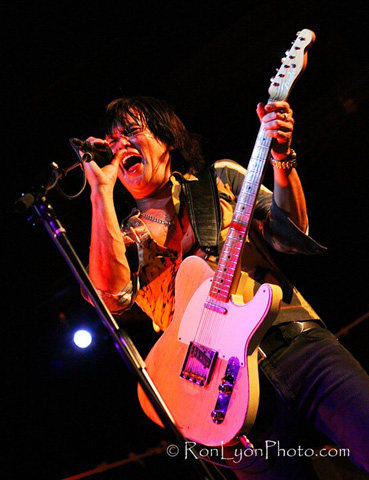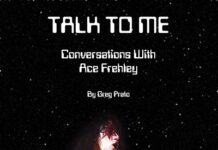Story by Shawn Perry
You have to respect these energetic vintage rockers who don’t want to waste time waiting for other vintage rockers to get their act together and head out on the road for the 700th time. A tour from the Who, who once declared they wanted to die before they got old, is always up in the air until the last minute — largely based on the mood and mindset of Pete Townshend. Lately, reports of the guitarist’s bout with tinnitus, a malady he’s experienced since the 80s, have suggested the Who could be winding down.
Hardly.
There is talk of the group taking Quadrophenia out on the road in 2012, to celebrate its long awaited and well deserved reissue. Still, Roger Daltrey, the other half of the Who, refuses to sit idle. So, he’s decided to take Tommy out for one more spin — this time without Townshend at his side.
“You can’t keep him down,” Frank Simes warns me during the break between the European leg and U.S. leg of the ‘Tommy Reborn’ tour. “He just doesn’t want to quit.”
As a Grammy-nominated guitarist, producer and songwriter who’s toured and recorded with such seminal figures as Don Henley and Mick Jagger, Simes is in a unique position to comment. He was hired by Daltrey to be the musical director of the tour, the singer’s first full-scale solo outing and a huge undertaking when you consider the legacy and logistics of the piece.
It was a big leap for Daltrey to entrust it with anyone outside his immediate circle. Although Simes had met the singer in 2003 through a mutual friend, producer Nigel Sinclair, they wouldn’t play together regularly until 2009, when the Who vocalist made that fateful call.
“He never actually went on tour as a solo artist,” Simes affirms me. “There were periods, when the Who were inactive, that he could have toured, but he couldn’t find anyone he could trust.”
The band, auditioned and hired by Simes, played select U.S. dates in 2009 and opened for Eric Clapton in 2010. When Daltrey decided he wanted to tackle Tommy, Simes wasted little time writing out the arrangements, assembling the musicians, and making sure the integrity of the Who’s landmark album wouldn’t be compromised.
“As the musical director, I had the task of parsing the whole opera,” Simes says. “I charted everything. I made chord charts. I made vocal charts. I made horn charts. I wasn’t sure if we were going to use horn players, but if we did, I was ready.”

Daltrey brought in Townshend’s brother Simon, a mainstay with the Who for years, to help augment the passages and vocal parts. Simes and the rest of the players — keyboardist Loren Gold, drummer Scott Devours and bassist Jon Button — were also tasked with important vocal parts on Tommy.
According to Simes, the Who never performed Tommy as it was originally conceived, which included a lot of vocal parts — “three, four, five, six part vocals. And nobody had ever really taken them apart,” the guitarist explains. “When the Who played, they only had the three vocalists. They hired some background vocalists later in their career, but early on, they just had the three vocalists — Roger Daltrey, John Entwistle and Pete Townshend. So they could only do three of, say, four part harmonies.”
He says the original Tommy album is “rich with vocals — even more so than Quadrophenia.” And because Simes wanted to be as faithful to the album as possible, he made vocals a high priority.
“Everybody in the band can sing,” he assures me. “Simon is singing the medium parts. The keyboardist (Gold) sings all the high parts, I sing the medium and low parts, the bass player (Button) sings the low parts, and the drummer (Devours) sings the low and medium parts.”
The musical director smiles and continues. “We can handle up to six-part harmonies. We can double up on the parts, if we need to. On a song like ‘Cousin Kevin,’ there’s two distinct parts and they’re both doubled.”
Simon Townsend also sings lead vocals on some of the songs. Simes says when they got together, he told Simon to learn all the parts that his brother Pete would have otherwise sung. “His voice uncannily sounds like Pete Townshend’s.”
But then at rehearsal, Daltrey wanted to mix things up. So, the guitarist explains, “He gave Simon some of the songs he used to sing. And Roger wound up singing some of the songs that Pete sang. He didn’t want to make things obvious.”
As for the lead singer’s voice, Simes assures me it’s in tip-top shape. “When we went on our first tour, he was struggling with his voice, quite frankly. But he had it taken care of and now he’s sounding 20 year younger.”
I ask Simes if he took liberties with any of musical arrangements of Tommy and he reminds me there was little room for improvisation, save for the occasional flourish here or there, in his quest to staying loyal to the original. “On Broadway, it was rearranged to suit Broadway,” he explains. “I wanted to reproduce it on stage as it was originally conceived and recorded. That’s what sets it apart.”
At the time of our interview, Simes tells me reaction to the live shows — which also include a handful of other songs, mostly from the Who, but not on Tommy — had been beyond all expectations in Europe where, the guitarist notes, “every show was sold out pretty much.”
He cites one gig in particular. “We played in Dublin and the kids were singing every word of Tommy. I’d never seen anything like it.”
And with the U.S. tour in full stride through November, it seems like the rebirth of Tommy has been successful on both sides of the pond. “The hair on the hand rises when it starts,” Simes says.

Despite the fact that the California-based musical director spent over 20 years on the road with Don Henley and has played countless gigs with a virtual who’s who (including Beatles) of rock and roll, he tells me he still gets nervous when the lights come down.
“It’s kind of scary when you play the large venues in the big towns, New York, L.A., London, Tokyo. The success, or a lack of it, reverberates in the world. The press picks up on it, and everybody knows if your show went well or not,” Simes pauses then politely adds, “it means a lot to us as performers that those shows went so well.”
Once the tour wraps, it’s likely Simes will stay busy with others projects, such as the musical he’s written with partner Lisa Verlo. “We’ve written several television treatments, children shows, documentaries. The musical is part satire about the entertainment business and part love story.”
Although intended for Broadway, Simes reveals that he and Verlo are now developing the musical as a feature film. “We have a 125-page script and a host of characters,” he says. “It’s quite a feat to complete such a large thing.”
With no immediate plans for additional Tommy shows after 2011, Simes floats the possibility of being part of the Who’s proposed 2012 tour behind Quadrophenia.
He says he met Townsend and the two struck up an instant affinity. He also says the Who’s guitarist has plenty of energy and that his tinnitus isn’t as problematic as everyone thinks. “He told me that after playing rock and roll all these years — ‘Doesn’t everybody have it?”’
When Woodstock happened, Simes was in the ninth grade and living in Japan (his father worked for the U.S. government there). Obviously, this made it difficult for him to make it to the actual Woodstock concert, but he saw the movie eight times and every time the Who came on, he says he was mesmerized. “I wanted to be part of that. I wanted to be at Woodstock. I wanted a bite.”
Whether in the studio with Mick Jagger or on the road with Roger Daltrey, Frank Simes has taken that bite, living out his wildest dreams as a musician, including playing Woodstock. The guitarist got his chance when he joined Stevie Nicks and Don Henley on stage at the 1998 ‘A Day In The Garden’ festival at Yasgur’s Farm in Bethel, New York — the actual site of Woodstock.
“Yeah, I played about a 100 feet from where Hendrix played,” he laughs. “And I got a little bite then.” No doubt, Simes has had to pinch himself as well many times since.





















